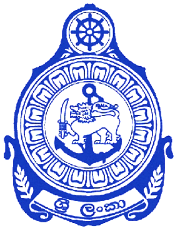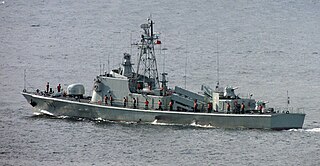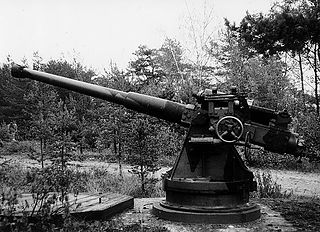
A cruiser is a type of warship. Modern cruisers are generally the largest ships in a fleet after aircraft carriers and amphibious assault ships, and can usually perform several roles.

In naval terminology, a destroyer is a fast, maneuverable, long-endurance warship intended to escort larger vessels in a fleet, convoy or battle group and defend them against smaller powerful short-range attackers. They were originally developed in the late 19th century by Fernando Villaamil for the Spanish Navy as a defense against torpedo boats, and by the time of the Russo-Japanese War in 1904, these "torpedo boat destroyers" (TBDs) were "large, swift, and powerfully armed torpedo boats designed to destroy other torpedo boats". Although the term "destroyer" had been used interchangeably with "TBD" and "torpedo boat destroyer" by navies since 1892, the term "torpedo boat destroyer" had been generally shortened to simply "destroyer" by nearly all navies by the First World War.
The United States Navy, United States Coast Guard, and United States National Oceanic and Atmospheric Administration (NOAA) use a hull classification symbol to identify their ships by type and by individual ship within a type. The system is analogous to the pennant number system that the Royal Navy and other European and Commonwealth navies use.

The P-15 Termit is an anti-ship missile developed by the Soviet Union's Raduga design bureau in the 1950s. Its GRAU designation was 4K40, its NATO reporting name was Styx or SS-N-2. China acquired the design in 1958 and created at least four versions: the CSS-N-1 Scrubbrush and CSS-N-2 versions were developed for ship-launched operation, while the CSS-C-2 Silkworm and CSS-C-3 Seersucker were used for coastal defence. Other names for this basic type of missile include: HY-1, SY-1, and FL-1 Flying Dragon. North Korean local produced KN-1 or KN-01, derived from both Silkworm variants and Russian & URSS P-15, Rubezh, P-20 P-22.

A missile boat or missile cutter is a small fast warship armed with anti-ship missiles. Being smaller than other warships such as destroyers and frigates, missile boats are popular with nations interested in forming a navy at lower cost. They are similar in concept to the torpedo boats of World War II; in fact, the first missile boats were modified torpedo boats with the torpedo tubes replaced by missile tubes.

The OTO Melara 76 mm gun is a naval gun built and designed by the Italian defence company Oto Melara. It is based on the Oto Melara 76/62C and evolved toward 76/62 SR and 76/62 Strales.

A fast attack craft (FAC) is a small, fast, agile and offensive warship armed with anti-ship missiles, gun or torpedoes. FACs are usually operated in close proximity to land as they lack both the seakeeping and all-round defensive capabilities to survive in blue water. The size of the vessel also limits the fuel, stores and water supplies. In size they are usually between 50–800 tonnes and can reach speeds of 25–50 knots.

The People's Liberation Army Navy Surface Force is a branch of the People's Liberation Army Navy in China. It consists of all surface warships in operational service with the PLAN. It operates 661 ships. The ships are organized into three fleets: the North Sea Fleet, the East Sea Fleet, and the South Sea Fleet. The People's Liberation Army Navy is turning away from its traditional focus on coastal and littoral warfare and instead prioritising the development of blue water capabilities. This has led to a significant reduction in fleet numbers as the PLAN has replaced a larger number of smaller ships with a smaller number of larger and more capable ships, including destroyers, frigates, corvettes, amphibious warfare ships and large auxiliary ships.
The People's Liberation Army Navy (PLAN) is the naval branch of the People's Liberation Army (PLA), the armed forces of the People's Republic of China. The PLAN force consists of approximately 250,000 men and over a hundred major combat vessels, organized into three fleets: the North Sea Fleet, the East Sea Fleet, and the South Sea Fleet.

The Sri Lankan Navy (SLN) is the naval arm of the Sri Lanka Armed Forces and is classed as the country's most vital defence force due to its island geography. The SLN is responsible for the maritime defense of the Sri Lankan nation and its interests.

The Type 037 corvette is a series 400–500 ton corvette type classes in service with the People's Liberation Army Navy. Unlike western navies, the People's Liberation Army Navy does not have dedicated patrol boats in its inventory. Instead, a large variety of corvette type classes, in the form of missile boats and submarine chasers fulfill the tasks of patrolling China's territorial waters. The Egyptian Navy operates eight vessels.

The Type 074 landing ship is a class of landing ship medium (LSM) of the People's Liberation Army Navy. They were built at Wuhu Shipyard of Wuhu, Anhui from 1995 to 2000. Although entering service in the mid-1990s, the origin of Type 074 dates to almost three decades earlier in the mid-1960s, and Type 074 is the result of experience learned from around half a dozen models earlier.

The Myanmar Navy is the naval branch of the armed forces of Myanmar with 19,000 men and women. The Myanmar Navy currently operates more than 125 vessels. Before 1988, the Myanmar Navy was small and its role in the many counterinsurgency operations was much less conspicuous than those of the army and air force. Yet the navy has always been, and remains, an important factor in Myanmar's security and it was dramatically expanded in recent years to an external threat defence role in Myanmar's territorial waters.

The QF 3-pounder Hotchkiss or in French use Canon Hotchkiss à tir rapide de 47 mm were a family of long-lived light 47 mm naval guns introduced in 1886 to defend against new, small and fast vessels such as torpedo boats and later submarines. There were many variants produced, often under license which ranged in length from 32 to 50 calibers but 40 caliber was the most common version. They were widely used by the navies of a number of nations and often used by both sides in a conflict. They were also used ashore as coastal defense guns and later as an anti-aircraft gun, whether on improvised or specialized HA/LA mounts.

The Sovremenny class, Soviet designation Project 956 Sarych (buzzard), is a class of anti-ship and anti-aircraft guided missile destroyers of the Soviet and later Russian Navy. The ships are named after qualities, with "Sovremenny" translating as "modern" or "contemporary". Most of the ships have been retired from active service and one converted into a museum ship in 2018, but several remain in commission with the Russian Navy. Four modified ships were delivered to the People's Liberation Army Navy, and remain in service.

The 75mm 50 caliber Pattern 1892 was a Russian naval gun developed in the years before the Russo-Japanese War that armed the majority of warships of the Imperial Russian Navy during the Russo-Japanese War and World War I. The majority of ships built or refit between 1890-1922 carried Pattern 1892 guns. During its career the role of the guns evolved from one of anti-torpedo boat defense to coastal artillery and anti-aircraft use.

The Canon de 100 mm Modèle 1891 was a French naval gun developed in the late 1800s that armed a variety of warships before World War I and during World War II. In addition to its naval role it was also deployed as coastal artillery.

















